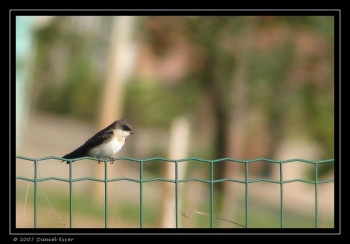
Photo by Robert Scanlon
La Suiza Nature Reserve, near Pereira, Colombia, May 2004
- Pygochelidon cyanoleuca
Notiochelidon cyanoleuca
Identification
11-12 cm
- Dark blue upperparts
- White underparts
- Blackish underwings
- Glossy black crissum
Juvenile
- Brown above
- Buff below
- Tail less markedly forked
Variation
The amount of black in the crissum varies geographically
Distribution
Central and South America:
Central America: Honduras, Guatemala, Nicaragua, Costa Rica, Panama, and rare in south eastMexico, only breeding in Panama and Costa Rica
South America: Colombia, Venezuela, Trinidad, Guyana, Suriname, Ecuador, Peru, Bolivia, Brazil, Paraguay, Uruguay, Chile, Argentina
Southern populations are long distance migrants that breed in Argentina and migrate to northern South America and Central America in southern winter.
Taxonomy
The species is also placed in genus Notiochelidon by some authorities[2].
Subspecies
Three subspecies are recognized[1]:
- N. c. cyanoleuca:
- Highlands of Costa Rica to Venezuela, Brazil and northern Argentina
- N. c. peruviana:
- Coastal Peru (La Libertad to Arequipa)
- N. c. patagonica:
Habitat
Common and widespread, especially in agricultural and urban areas upto 4000m. At least in Chile always connected with water.
Behaviour
Breeding
Both sexes build a shallow nest from straw. The clutch consists of 6 white eggs; incubation (15 days) and feeding the young is carried out by both parents until they fledge at about 26 days. There may be two broods.
Diet
Their diet consists mostly insects caught aerially, including ants, wasps and flies.
References
- Clements, J. F., T. S. Schulenberg, M. J. Iliff, D. Roberson, T. A. Fredericks, B. L. Sullivan, and C. L. Wood. 2014. The eBird/Clements checklist of birds of the world: Version 6.9., with updates to August 2014. Downloaded from http://www.birds.cornell.edu/clementschecklist/download/
- Avibase
- Ridgely & Gwynne 1989. Birds of Panama. Princeton Paperbacks. ISBN 0691025126
- Richard ffrench. 1991. A guide to the Birds of Trinidad and Tobago. Comstock/Cornell Paperbacks. ISBN 0-8014-9792-2
- Howell & Webb, 1995. A guide to the birds of Mexico and northern Central America. Oxford University Press. ISBN 0198540124
- Handbook of the Birds of the World Alive (retrieved February 2015)
- Wikipedia
Recommended Citation
- BirdForum Opus contributors. (2024) Blue-and-white Swallow. In: BirdForum, the forum for wild birds and birding. Retrieved 9 November 2024 from https://www.birdforum.net/opus/Blue-and-white_Swallow
External Links
GSearch checked for 2020 platform.1





